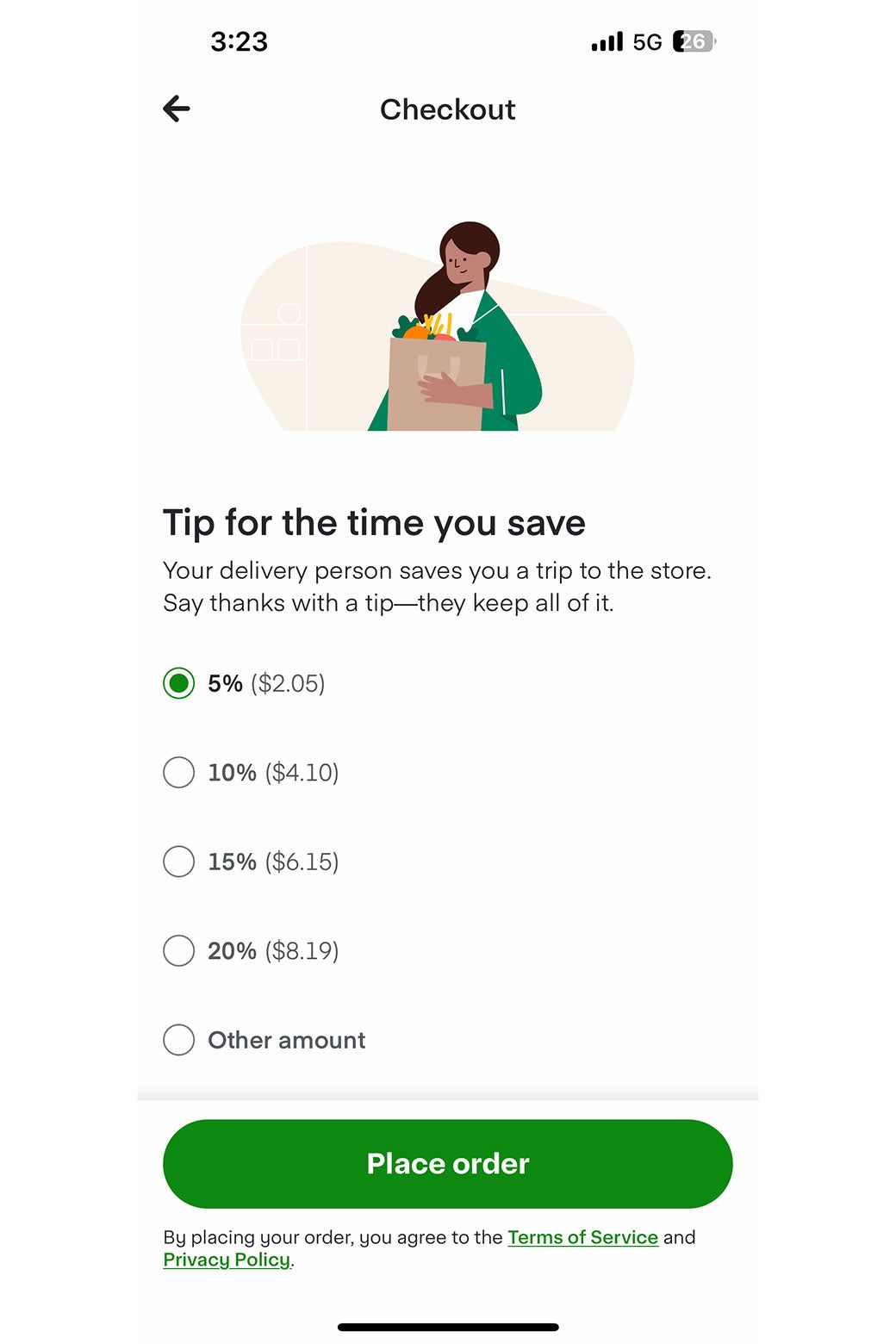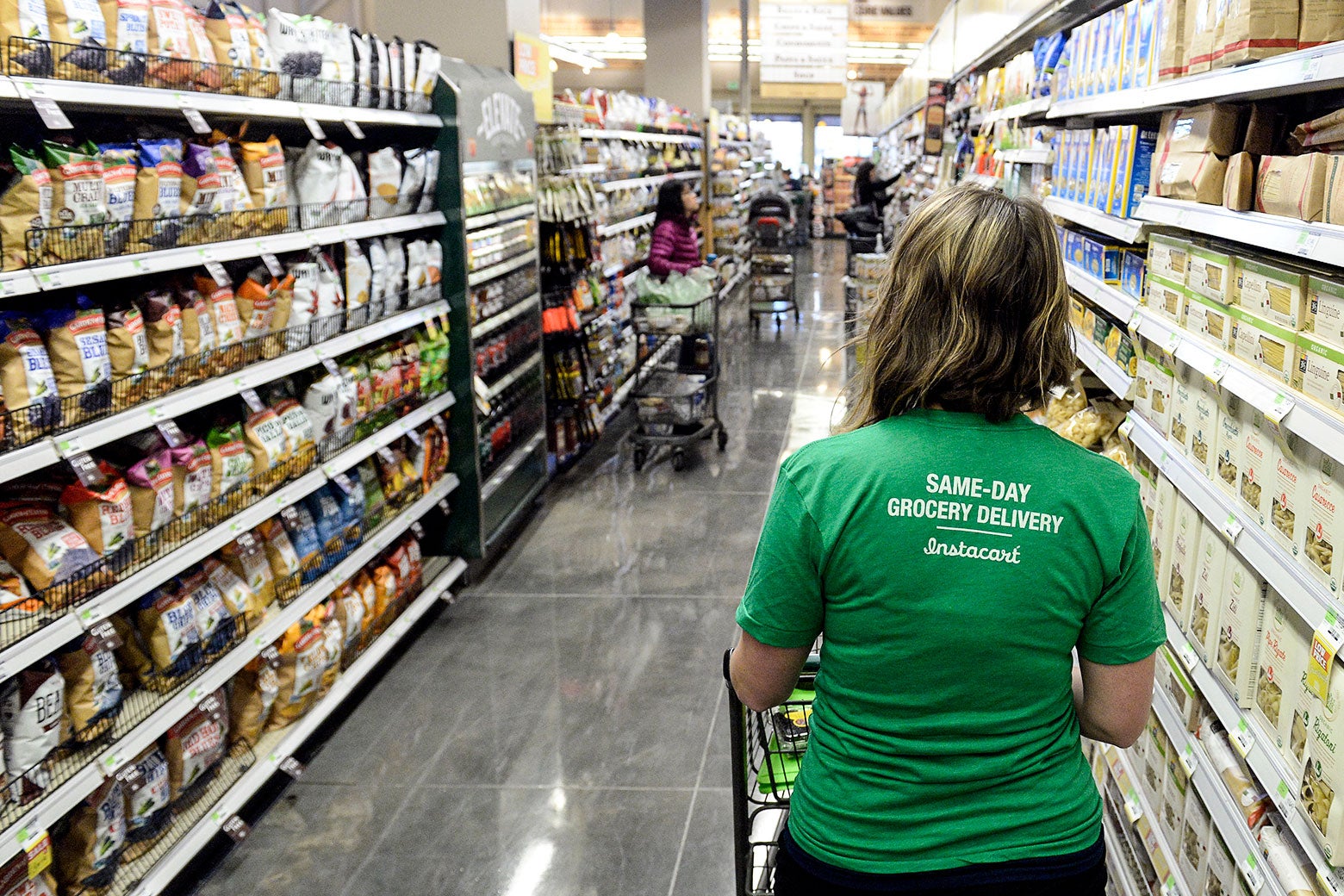He’d long had a policy against accepting Walmart orders. When you’re an Instacart shopper, speed matters. In contrast with most grocery stores, the products at Walmart are quite spread out. Still, the number that appeared on his Instacart Shopper app was tantalizing. Quan Tsang would make $130.75 for the 111-item order if—and this is always a big if—the customer followed through with the promised tip of $94.77.
Tsang opened it up to the other delivery people who follow him on TikTok, asking, “Would you take this Instacart batch?”
“Hell yeah,” one follower wrote. It was among the biggest batches many of them had ever seen. But others were cautious, given that customers have two hours, after their order has been delivered, to reduce their tip. “Tip baiting”—when a customer lists a misleadingly high tip to get someone to quickly take the job—happens.
“Nope because I would hate to have to burn their house down if it was a tip bait lol,” one woman wrote. (Instacart has offered to compensate shoppers, up to $10, in some tip-baiting incidents.)
Without the tip, Tsang, who lives in pricey Orange County, California, would be using up gas to schlep to Walmart for a grand total of $36 to $46.
Tsang hit accept.
It’s this kind of calculus that has helped make Instacart, as of this week, a more than $8 billion public company. The grocery delivery service debuted on the Nasdaq on Tuesday at around $30 a share, making its young founder a very rich man and inciting conflicted feelings among the shoppers that the tip-reliant business model depends on.
Last year, around 7.7 million individuals and companies regularly ordered groceries and home goods from Instacart. The company acquired these customers without hiring a single full-time delivery person. The people who do the grocery shopping and transport bags to customers’ doors are all contract workers like Tsang who travel in their own vehicles. In most of the country, they get no hourly wage, and the flat fee—attached to most orders—is tiny; in July, ahead of its IPO, the company lowered the minimum pay from $7 to just $4. The company bumps this figure up a little based on factors like total items and distance. But ultimately, the only reason high-caliber shoppers like Tsang have stuck around—beyond valuing the schedule flexibility—is the tips that make up the bulk of their payout.
The shoppers I spoke to feel that—now more than ever—Instacart needs to do a better job helping them get those tips. Their requests were straightforward. Many urged doubling tipping defaults from 5 percent—the option that Instacart suggests for large orders—and $2—the default option that Instacart places on many small orders. Still others urged Instacart to take responsibility for making it more clear to customers how their delivery workers get paid.
We all know that in the United States waitresses and bartenders get most of their income from tips. But that’s not necessarily true in the delivery industry. FreshDirect, an online grocery provider that is popular in the New York area, pays an hourly rate. Blue Apron, one of a handful of other publicly traded food-delivery companies, outsources shipments to non-tip-based companies like FedEx. Further adding to the confusion, Instacart often lists a “service fee” that doesn’t actually go to shoppers. (Instacart states this on its site, but it’s easy to get confused by the invoice.)
In a conversation about compensation, a spokesperson for Instacart said that the company supports shoppers by getting them tipping and batch payment information upfront. The company has touted the many ways it says it’s trying to boost tips for shoppers, including urging customers who gave five-star ratings to increase the amount. But without understanding that their shoppers are working almost entirely for tips, a customer might think that adding one more dollar to a $600 order is generous.
As Tsang entered the Foothill Ranch Walmart in Lake Forest, California, he scanned his list and looked at the Instacart timer. Each order offers a goal time. Tsang always beats his by a long shot.
“I take a lot of pride in my shopping speed,” Tsang said. Surpassing it does not come with a reward. It simply means you are available to take on more orders.
Tsang likes working as a shopper partly because it allows him to watch his kids while his wife is in school. He works seven days a week and responds to Instacart orders from 11 a.m. to 1 p.m.
and from 4:30 to 8:30 p.m. Since he’d only spotted the order at 6:30, he hoped he could still pull it off. He didn’t have the store mapped in his head, so he got off to a slow start once inside.
Shoppers may not know exactly what’s in the batch until they’re in the store. This can make for some uncomfortable surprises … like sex toys. (It happens!) There was nothing like that this time, but he was frustrated to find that he had to return to the makeup area about 10 times to get someone to unlock a desired item for him. And that the customer kept adding items as he shopped. By the end he had two carts, overflowing with organizational containers. Checkout took 20 minutes.
The actual delivery is where things get interesting. On the positive side, you might meet a customer who insists on knitting your baby a blanket. This happened to Angela Davis, who worked as an Instacart shopper in Maryland throughout her pregnancy. (She’d be even more pleased, she said, if Instacart compensated shoppers for good ratings.)
On the challenging end, some customers want to talk … and talk. Sometimes allowing a lonely stranger to share a story feels good, said Jessica Smalley, a shopper in Portland, Maine.
Sometimes it’s stressful.
Some customers do strange things, like insist on praying for you in tongues, Sara Amber Victoria, another shopper in Southern California, told me. (That’s not her real name, but the one she uses on social media.) She also once had a man open the door fully clothed, only to undress further each time she brought in a bag. “The last time I went up, he was in his underwear. I got out of there SO quick!” she wrote to me. She reported him to Instacart.


For Tsang, the Walmart delivery customer turned out to be perfectly, unremarkably pleasant. Two hours and 40 minutes after he’d accepted his order, Tsang was ready to call it a night. Soon after he arrived home, he confirmed that the tip came through: He’d made $135, around $45 an hour. This was well within his goal of $30 to $50 bucks an hour. (This is double many other shoppers’ goals.) And for some shoppers, particularly those working in lower-income, lower-tipping, lower-demand areas, this would be a reason to celebrate. (One shopper in Atlanta shared on TikTok that she’d been struggling to make $150 a week through Instacart lately—a huge drop from pandemic times, when she could make $1,500 to $2,000 a week.)
But Tsang felt mildly irked. No, this was not one of those lawsuit-inspiring reports from a few years back of shoppers making a few bucks an hour. Still, he’d hoped for a 10 percent tip on an order of that size, but he was pretty sure this was lower. He couldn’t be certain because shoppers never see how much customers pay—$98 is 9.4 percent of the $1,042 Walmart charged. But the Instacart app routinely marks up items on the customer end. (Instacart kicks markup responsibility to the stores, which the company says prices items for Instacart delivery.) He suspected it might have actually been closer to a 7 percent tip.
Like other shoppers I spoke to, Tsang felt that Instacart should adjust the default tip setting to 10 percent. Studies show that defaults heavily impact how much people pay, even if they can modify the amount.
In 2022, customers spent, on average, $317 per month, according to Instacart’s own Securities and Exchange Commission filings. Grocery orders of $200 are pretty common in Southern California, Tsang said. At 5 percent for a tip, that means shoppers could only expect a $10 tip on top of the base batch pay of perhaps $4 to $7.
“All they need to do is set the default to 10 percent and so many shoppers will be far better off,” Tsang said.
It could also be good for Instacart. As the company states in its SEC filings, one of the biggest risks to the future of its business is failing to retain quality shoppers. It’s hard to keep people at $14–$17 for an hour and a half of work.
Correction, Sept. 26, 2023: This article incorrectly described several aspects of Instacart’s payout system. It reported that Instacart always includes a $4 service fee and might offer $4 to $7 base pay for a $200 order; in fact, while $4 is often the service fee, it can be more or less, as could the base pay on a $200 order. The article has also been updated to clarify that while there can be surprise additions, Instacart shows shoppers most items in advance.
